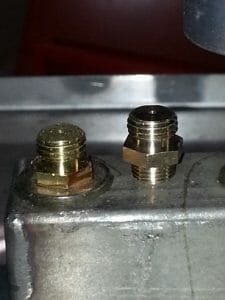You’ve lugged your bargain Craigslist or Ebay or Coffeetec bargain roaster home, connected an LP tank, mashed the igniter or ignition button and nothing happened.
Or equally bad, you have way less heat than you need or flames shooting out the sides of the machine.
Now what?
Over the last 8 (!) years, this post has gotten a lot of traction. It turns out quite a lot of you guys are searching the internet for ways to get your undocumented and unsupported used commercial coffee roaster running and the single most incomprehensible thing you’ll run into is often the most overlooked part of the whole machine.
Fuel gas.
For many, their first option is to post a burner question online. They’re then answered by a host of well-meaning amateurs that chime in with the ways they solved their problems, leaving out critical details like the time they charred their eyebrows off or blew the doors off their chaff collector.
Cue sad trombone.
You could be forgiven for thinking the gas burner on your coffee roaster is pretty simple, right?
It turns out there are innumerable permutations of regulators, burners, orifices, inlets, outlets, etc. Compounding this is the choice of either natural gas or liquid propane.
If you’re wondering how complex some of this really is, spend a week deciphering how orifices actually work: Engineer’s guide to orifice sizing
-and then spend a couple of years choosing components, figuring out how they work together, and then teaching yourself how to set up a heat source in a way that optimizes batch size, efficiency, and control.
If you have a burner problem on one of our roasters, we’ll probably work with you to troubleshoot the issue by verifying every component in the gas chain. The old saw “you can’t beat a dog at his own game” applies here. It’s not all that complex, but all of this is vastly more comprehensible to a technician that makes a living looking at this kind of thing every day.
If you really want to know your theoretical max BTU, I’ve included a link to “Gas Orifice Capacity Chart.” Find your orifice size and multiply the CFH by 1000 for natural gas and 2517 for LP
If you don’t know what size that tiny hole is, spend $10 on a wire size drill bit set and use the shank end (the opposite end from the cutting end) as a gauge pin. The largest one that will fit in the hole is your orifice size. Then you can use the chart to calculate the maximum heat output of each burner. Multiply by the number of burners and you’ll know your max BTU capacity. Simple, right?
If you can’t get enough heat, maybe not, because more gas doesn’t always mean more BTUs. Combustion efficiency is a product of a very specific fuel to air ratio and requires carefully calibrated mixing. Critical geometry includes the gas orifice, but also takes into account burner type, actual burner design, and the distance from the surface of the drum as it relates to the amount of time the gas is available to be consumed.
Weird, right? It’s almost like your roaster is an engineered system.
Ours are anyway. Yours might be.
The key takeaway here is that we’ve left very little to chance. There are very few bargains in production machinery. Used machines are discounted for somebody else’s problem. If their problem was only a flawed business model, you’re golden. If their problem was the machine, you’re sunk.

